|
Part Four: The Ribbon of
Mist Comes Downstage
or Drifting Into The
Unknown
"There are ways but THE WAY
is uncharted."
“First you shoot the
arrows and then you paint the targets.”
Statement by a friend at
University of Colorado
“When going outside into
the world, hold hands.”
Robert Fulghum, from
Everything I Need To Know I Learned In Kindergarden
Where have we been? From our ordered, balanced world,
we journeyed into places where we need love and reason to
guide us. While drifting along, like an interlude in a
musical score, we got to know some of our companions, a
little about our self and we fancied who we might like to
take along on this trip as fellow travelers. It was a time
to allow our imaginations to drift too. We left the baggage
of time, job, worries and home behind us. When we left an
island where we had rested, there was sadness on leaving and
excitement about seeing what lay ahead. We were given
shelters where we could reflect on what we had seen and
guess what might come next. Again, the scenery changed
slightly (not enough to shock us but enough to keep our
interest). We saw the mists for the first time and a few
pockets of mists came forward but not enough to engulf the
clarity of our vision. We allowed ourselves the luxury of
drifting.
Orientation: As your guide, I must remind you to
check your knapsack for the essentials of this trip: your
imagination, your vision, your mind and spirit, your
attention to detail, your ability to thin slice, your
inquisitiveness (shared with the others on the trip) and
your memories. OK, if all that is packed, it might be time
to move out into the lake and slowly sail to our next
adventure. But before we do that, we must recognize that
this is a “work of art” (the work is the housing for the
art). The critical word here to examine is “of." The work is
all the details that I have pointed out. The art (the
creative thought-process behind the work) may be hidden at
times. As you saw in the last part of our peace journey, I
am an artist so I can, at certain points in your voyage, put
myself into the skin of this Chinese painter on silk.
Many through history have asked the question, “What is art?”
Some on our trip might say, “It is a painted, hand scroll
landscape.” But that is the “work” that reflects the art
which is the thoughts, emotions, memories, and visions of
the artist. Art is a risk. One never knows where the trip
will lead (although you start with a plan which must change
as time passes). Art is like jumping into a deep lake,
keeping yourself afloat with the actions of your limbs (now
that is “work”) until a boat comes along (an idea or image)
and takes you further along your journey. Art is the
creative imagination in action, seeing a little beyond where
the ordinary viewer sees, and having the courage to move
ahead.
Two Artist Companions: When I was studying Chinese
painting history with Dr. Li at NYU in New York, one of my
fellow students was Alan Kaprow, the artist who gained
international fame with his “happenings”, works of art in
time and space, with a script and ordinary participants.
Where Alan’s happenings led even surprised him sometimes. We
were sitting in a restaurant, sipping, eating and relaxing,
and discussing the difference in how we approached the
unknown. He said that he used everything and I said that I
took some things away until I had the essence of the
creative experience. We both exaggerated (I will not say,
“Lied!” but we did embellish reality). Alan told me how he
learned to go on his trips with the “happening” in a state
of patience (much like Sam did at the poker table and B in
the insurance business): “I love to stand in line, waiting
to go into a theater that is playing something I wish to see
or just stepping into a line to wait with others for no
reason. It teaches me patience.”
As director of an art museum in Waco, Texas, I asked Robert
Wilson (whom I had met in Boston at the opening of three acts
of his Civil Wars (a 17-hour play which was composed for
six continents and was to be brought together for the 1984
Olympics in Los Angeles. It never came together since the
money ran out), opening at the Cambridge Repertory Theater,
and an exhibition of his drawings at the Boston Contemporary
Museum of Art) to create a work of art for his home town,
Waco. Wilson was better known in Paris, France than on the
streets of his birthplace. Houston had recently had him
direct the Houston Opera, a play at the Alley Theater, and
opened a massive exhibition of his work in the Contemporary
Art Museum. Bob is a Renaissance man for the 21st
century. His reply to my request was swift, “I want to
create a twenty-two foot high, core-ten steel (that rusts to
a point, leaving a marvelous patina) door, partly open.”
When he came to see the site, he walked all over the museum
grounds, down the street out of sight, and then returned.
“This place,” he said, “was the home of the Cameron family.
They had owned this whole hill. Their home was called
‘Valley View’ because of the sweeping vista of the Brazos
River and the flat plain to the east. I want to place it
here (pointing the ground), partly open. It will be a open
door to or from nature. I want pathways and walkways around
it so that it can be seen from many points of view.” At that
moment, we made a contract with our handshake. "The Door" has
become a symbol in that region of the country for the “open
imagination” of the artist in all of us. The work of
building “The Door” was done on the West Coast while Bob
opened a play in Sweden and Tokyo, money was moved through
the Parsons Gallery in New York and directed to his Byrd
Hoffmann Foundation (Bird Hoffmann was a dance teacher that
told him to slow down his speech, since he stuttered until
the age of seventeen, and he did with enormous success. At
the same time, he slowed down the world in his art work.)
Robert Wilson is a model for the 21st century
artist who separates making the work from his art (the
creative act of envisioning what it will be).
What have you been doing while we journey along on this
lake, stopping and reflecting on where we have been, and
trying to notice all the details in this water/landscape?
Everyone around me noticed that I carry a notebook and make
sketches and notes in it. As your guide on this trip, I feel
that it is my job to record what I see and make some
decisions on their possible meaning to the whole experience.
Here are two sketches for Part Four:
 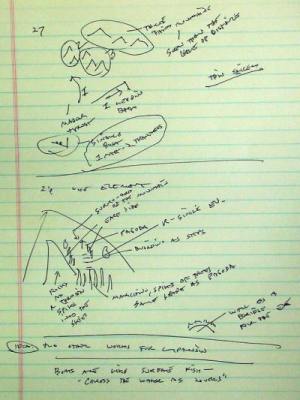
Rule Six: Your mind is not
a storage unit (although sometimes a tool box and index
sorter). Keep most data in notebooks, computers, libraries
and other places that can be accessed. The notes are mind-
joggers.
It is time to thin slice
our vision again:
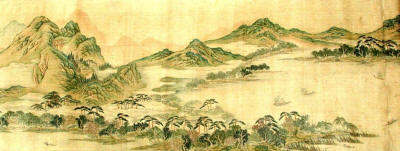
The mist is a ribbon that ties the background to the
foreground, acting as an open backdrop for the arrows of the
Evergreens.
Mountains cluster in rhythms like notes in a lake melody.
The first major Northern Sung mountain is introduced.
Bulrushes and sadness are still our companions.
The numbers: One, two, three, four and six are played
upon.
A many-layered, pointed Pagoda is nestled within the
shelter of guardian, needle fern trees.
On the far left is a major Northern Sung mountain with a
pagoda temple on its right shoulder. As your guide I should
point out that the line of trees at the bottom has taken
over the position of a frame (a job held by the mountains
and hills in Part One at the top of the scene) and they give
a foundation now to our imagination to fill the void. A
ribbon of mist which starts high up on the right side has
snaked its way to the foreground. Now, more is hidden than
revealed. The unknown is more dominant than the known. By
the composition, we are implored to search the space above.
Our bulrushes on the right side lead toward the future but
instead of being at the end of the island they are now at
the beginning. They stand as sentinels of the future. Old
friends are still with us: the Evergreens, the mists, walled
fortresses, boats, islands, hills and the mountains (that
have become massive statements stopping our vision for a
moment so that we are forced to explore them).

We have moved to a landscape where there is more emphasis on
space than substance. The mist is now the nervous system of
the scene and the boats, numbers (2, 3, etc), mountains,
trees are the underlying beat. We are carried along by the
music of the landscape (the water, the mist and the isolated
notes of boats).

The rolling mountains on the right side descend to the boats
like musical notations: two mountains to one peak to boats isolated on
the lake. The mist is the melody. All else is secondary as
an underlying heartbeat.
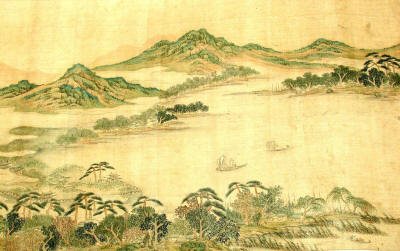
Art works have traditionally had four elements by which they
were appreciated and judged: usefulness, realism, feeling
and form.
Usefulness: A Ming Dynasty hand scroll is useful in
that it is a work of art that is taken out and exhibited
only on special occasions. In the West, we are used to
exhibitions being held in rooms with each work hanging alone
with enough space around it so that it can breathe. That is
the essence of freedom and democracy. In a Chinese scroll
there is freedom also but it is the freedom of each element
(not the whole) to exist in its own realm, its own space, at
some point in the work. As one artist friend said to me in
Taiwan, “I have the freedom of silence.” The usefulness of
the scroll is its use in the ceremony that surrounds the
meeting of friends in fellowship. The eating and drinking
and viewing are all part of a ritual.
Realism: Most cultures, and China is no exception,
see realism as pertaining to the likeness of things as a
society generally describes them. Realism is
representational (the object or scene represents something
that everyone recognizes as “real." The boats float on the
surface of the lake, the companions stop to reflect when
they become tired and their shelters (huts, temples,
housing, jutting rocks, etc) look like what we expect them
to be. The sky is up; the earth is down; the mists float
over everything; the lake flows around the islands and the
mountains are anchored to the land. We call that “real." We
are comfortable in a seemingly real world (I say seemingly
because you do remember from Part One that there were five
masts shown over only four boats).
Feeling: What we have felt to this point is
contentment in the formal order of the world, ABA; surprise
when this order changed, sadness on leaving someplace where
we had found shelter and a place to reflect, love of certain
objects: colors (green, pink, black and brown), movements
(the serpentine mist), stability (the majestic mountains
wedded to the earth), fellowship with our companions and
wonder in the vastness, and anxiety with the movement toward
the unknown and unknowable. Feeling is not of the mind but
the heart and spirit. It is an important ingredient in
judging a work of art when the meanings are shut behind the
“closed door” of the unconscious.
Form: In 20th and 21st century
art, form is the dominant element in seeing what makes up
the work of art. In this hand scroll, your guide can point
out a sequence of numbers starting on the right side of: (2)
two willows, (1) then one willow, (2) evergreens, (3)
evergreens, (4) evergreens, (3) evergreens, (2) shelters,
all leading to (1) great mountain form. The dragon spine
down the side of the mountain leads us to the end of a
ribbon of mist. Below the trees, on the lake, starting to
the right and moving left, (1) boat with (2)masts and (1)
passenger, leading to (1) boat with (3) masts and (2)
passengers. Below those lonely boats on the lake are the
bulrushes leaning to the left where we find (2) shelters
which eventually lead us to the mountain side where (1)
pagoda is flanked by a multitude of sharp-pointing trees
which stand as guardians for the temple with (2) two
isolated trees beside it
Story of Travel: In 2001, while on a Fulbright
Scholar’s grant to Georgia (Eastern Europe-Russia), I was the artist in residence
for the USA at an International Symposium of Artists
Workshop for a month in a small city 75 miles south of
Tbilisi, Georgia. Every day we worked on our creations,
getting ready for a large exhibition in the middle of
September. One hot day just to rest and relax, a Georgian
friend, his wife and their two children took my wife and I
to the Black Sea for a day at the beach. When you have been
working everyday, it is hard to stop so I decided while I
lounged around I would do some drawing from Georgian writing
(which I loved for the roundness of the form and the way
that it reminded me of Renoir’s women). I asked my host to
write “sky”, “sea” and “sand” in Georgian. He did. I started
to play with the forms, connecting the letters and seeing
how I could make something that was interesting and also
emphasized the fullness of their letter forms. Here is what
I created:
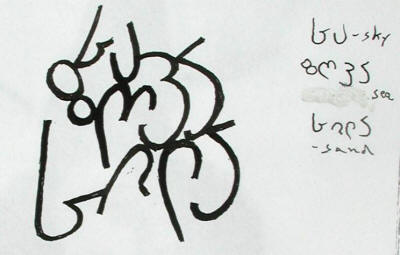
So it is with the forms that I find in this Ming hand
scroll. I want to see how they go together in a way that
pleases me and has a hint of reality to the process. Your
understanding of these forms is less important than your
recognition that there is a sequence and an ordering of
numbers to the simplest of shapes and details.
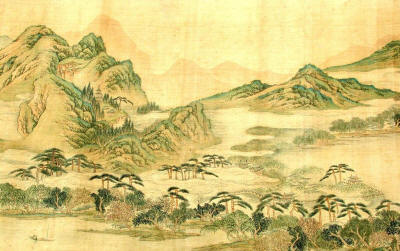
As we move forward, we see, on the left, two sharp peaks of
mountains with three similar peaks below those. Above are
three hardly visible, faint mountains in the distance,
giving us a sense that this scene is repeated all over the
world where we have water and land pushing to the sky. Below
the major mountain mass, on the lake, we view (1) boat with
(2) passengers and (1) mast that is heading back the way
that we came. It is the first image that goes backwards in
our journey.
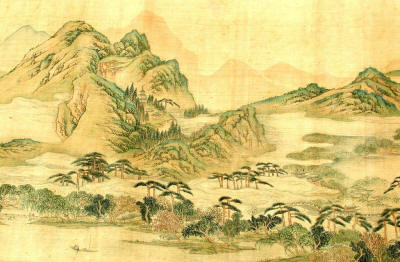
Let’s Rest On One Object:
Let’s thin slice the dominant mountain and what it holds.
Pyramid of a mountain with pyramids of rock making up its
shape and form.
Pagoda placed at a golden section juncture; a little to
the right and a little past center up the mountain.
A single evergreen beside the pagoda which is built in
multiple layers.
Clusters of needle-pointed trees standing guard around
the pagoda.
Buildings as visual steps leading us to the pagoda.
One rock beside the pagoda as a thrusting force moving
our eye upward.
And down in the lower right hand corner is a fortress wall
that resembles and symbolizes a bridge for our travels and
our imagination. While all this is going on, the mist is
wrapping itself around every shape, every element and every
solid thing.
Rule Seven: When in a
foreign country, remember that you are the foreigner. The
world outside ourselves is foreign to us but we are what
must adjust, not the environment.
What forms intrigue you? What emotions does this trip
bring to the surface? What do you call “real” and what is
not “real”? Are any of the tools that your guide has given
you helpful (are they of “use”)? Send us your comments.
|

